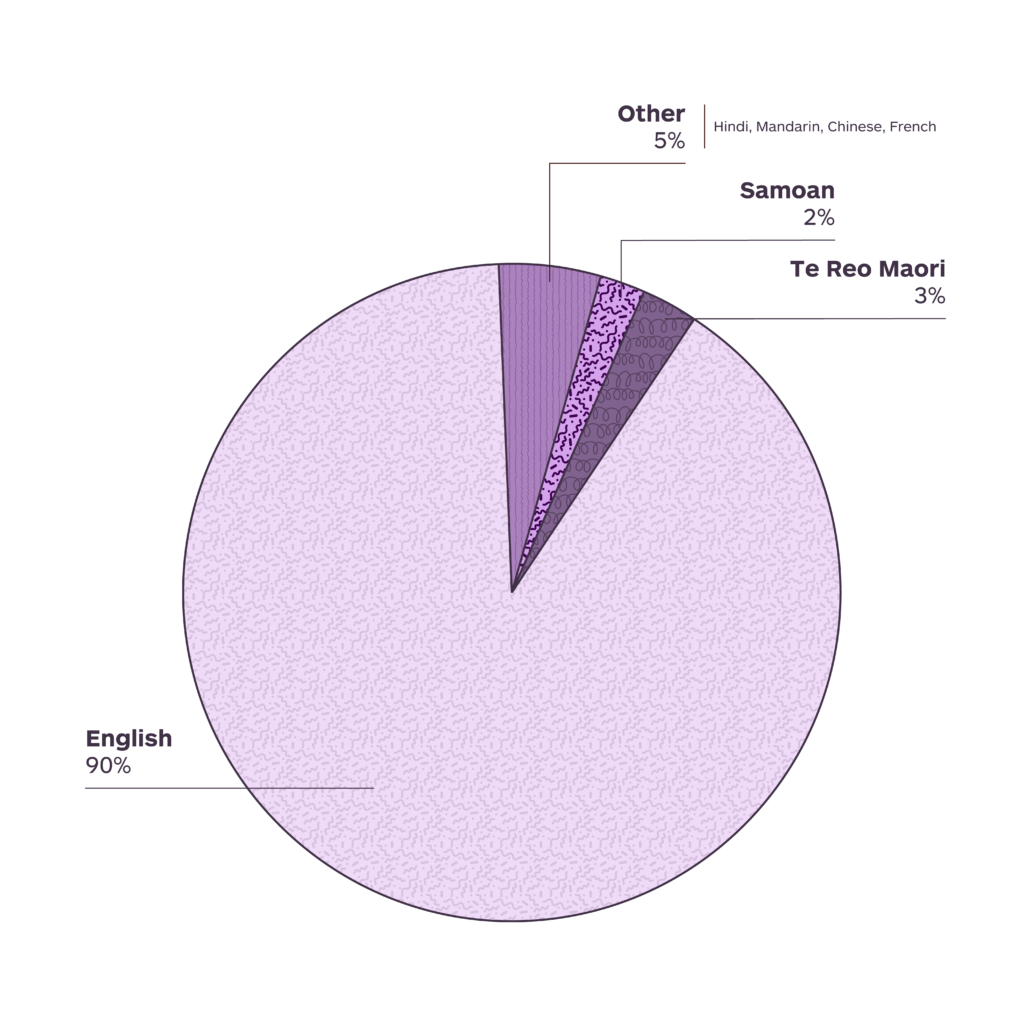Oceania
To which language should you translate to localize in New Zealand?
LANGUAGE INSIGHT
Official language
English (72.6%; 3.79 mln), Te Reo Māori (3.5%; 182k) and New Zealand Sign Language
Actual languages
English (72.6%; 3.79 mln), Te Reo Māori (3.5%; 182k), Chinese (2.2%; 114k), Samoan (2.0%; 104k), Hindi (1.6%; 83k), French (1.2%; 62k), other (16.9%; 882k)
What the top 150 best localized websites in the world do in New Zealand
(Top 150 websites listed in the Global by Design ranking – published annually by Byte Level Research, this report provides a list of globally localized websites, showcasing best practices and emerging trends in their globalization)
- 129/150 localize by translating into English
- 1/150 localizes by translating into English, Samoan, Samoan Sign Language, Niuean, Te Reo Maori and New Zealand Sign Language
- 1/150 localizes by translating into English, Samoan Niuean and Te Reo Maori
- 1/150 localizes by translating into English and Simplified Chinese
- 1/150 localizes by translating into English, French, Spanish, Italian, German, Portuguese, Russian, Simplified Chinese, Traditional Chinese, Japanese and Korean
- 1/150 localizes by translating into both English and French
- 1/150 localizes by translating into English, French, Spanish, Italian, German, Portuguese, Simplified Chinese, Traditional Chinese, Japanese, Swedish, Polish, Arabic, Czech, Hungarian, and Dutch
- 1/150 localizes by translating into English, French, Spanish, Italian, German, Portuguese, Russian, Simplified Chinese, Traditional Chinese, Japanese, Polish, Hungarian, Romanian, Bahasa Indonesia, Turkish, Thai and Ukrainian
-
3M
-
ABB
-
Accenture
-
Adidas
-
Adobe
-
Airbnb
-
Aldi
-
Amazon
-
American Airlines
-
American Express
-
Apple
-
Audi
-
Autodesk
-
Avis
-
Bayer
-
BMW
-
Booking.com
-
Bosch
-
British Airways
-
Bumble
-
Burberry
-
BYD
-
Canon
-
Capgemini
-
Cartier
-
Caterpillar
-
Chevrolet
-
Cisco Systems
-
Citibank
-
Coca-Cola
-
Costco
-
Dell
-
Deloitte
-
Delta
-
DHL
-
Disney+
-
Dyson
-
eBay
-
Eli Lilly
-
Emirates
-
Ernst & Young
-
Facebook
-
FedEx
-
Ford
-
Four Seasons
-
Fujifilm
-
GE
-
Gillette
-
GoDaddy
-
Google
-
Gucci
-
Haier
-
Heineken
-
Hermès
-
Hertz
-
Hilton
-
Hisense
-
Hitachi
-
Honda
-
Hotels.com
-
HP
-
HP Enterprise
-
HSBC
-
Huawei
-
Hyatt
-
Hyundai
-
IBM
-
IKEA
-
Intel
-
InterContinental Hotels
-
J&J
-
Jack Daniel's
-
Jehovah’s Witnesses
-
John Deere
-
Kellogg's
-
Kia
-
KPMG
-
L'Oréal
-
Land Rover
-
LEGO
-
Lenovo
-
Lexus
-
LG
-
Louis Vuitton
-
Lululemon
-
LUSH
-
Marriott
-
MasterCard
-
McDonald's
-
Mercedes-Benz
-
Merck
-
Microsoft
-
Mitsubishi Electric
-
Nestlé
-
Netflix
-
Nike
-
Nikon
-
Nintendo
-
Nio
-
Nissan
-
NIVEA
-
Oracle
-
Pampers
-
Panasonic
-
PayPal
-
Pepsi
-
Pfizer
-
Philips
-
Pitney Bowes
-
Porsche
-
Procter & Gamble
-
PWC
-
Revolut
-
Rolex
-
Royal Caribbean
-
Salesforce
-
Samsung
-
Sanofi
-
SAP
-
Sephora
-
Shopify
-
Siemens
-
Sony
-
Spotify
-
Starbucks
-
Steelcase
-
Stripe
-
Subaru
-
Tesla
-
The Church of Jesus Christ of Latter-day Saints
-
Tiffany
-
Tinder
-
Toshiba
-
Toyota
-
TripAdvisor
-
Uber
-
United Airlines
-
UPS
-
Visa
-
Volkswagen
-
Volvo Cars
-
Vrbo
-
Walmart
-
Western Union
-
Wikipedia
-
Wise
-
WordPress
-
Workday
-
Xerox
-
Xiaomi (Mi)
-
Zara
-
Zoom
If you need others information, below you can find a selection of economic/social/cultural data
Overview
Language
Official language
English (72.6%), Te Reo Māori (3.5%) and New Zealand Sign Language
T-index
0.24%
T-Index ranks countries according to their potential for online sales.
Other languages
Chinese (2.2%), Samoan (2.0%), Hindi (1.6%), French (1.2%), other (16.9%)
Demography
Capital: Wellington
Currency: New Zealand dollar
Population: 5.223 mln (2023)
Population density: 20/km2
Economy
GDP: 253.5 billion USD (2023)
GDP per capita: 48,527.83 USD (2023)
Exports: $46.5 billion (2022)
Statistics
Internet users: 95.7% penetration, 5.03 million
Unemployment rate: 4.8% (2022)
Urbanisation: 86.98% (2023)
Literacy: 99% (2018)
Conventions
Numbering system
Arabic numerals with dot as decimal separator, comma as thousands separator
Date format: dd-mm-yyyy
Time: 24h time system
Country code: 0064
Language data sources: Worldatlas/Britannica//EF/Wikipedia; Demography data sources: IMF/Worldometers; Conventions data source: Wikipedia; Economy data sources: WTO/OEC/CIA/Esomar/Datareportal; Statistics data sources: Datareportal/WorldBank/UN/UNESCO/CEIC/IMF/Culturalatlas/Commisceoglobal/Worlddata.info
Facts and data
Economy
Imports
$51.5 billion (2022). Refined Petroleum ($5.4B), Cars ($3.94B), Delivery Trucks ($1.32B), Gas Turbines ($1.28B), and Broadcasting Equipment ($1.2B), importing mostly from China ($11B), Australia ($7.3B), United States ($3.96B), South Korea ($3.45B), and Singapore ($3.3B).
Financial inclusion factors (over 15 years of age)
• 98.8% have an account with a financial institution
• 57.2% have a credit card
• 80% make online purchases
Ease of doing business
It is extremely easy to conduct business (rated 86.8 out of 100) ranked 1st out of 34 OECD high income countries, ranked 1st out of 190 countries worldwide (2023, World Bank).
Exports
$46.5 billion (2022). Concentrated Milk ($6.99B), Sheep and Goat Meat ($2.79B), Butter ($2.78B), Frozen Bovine Meat ($2.71B), and Rough Wood ($2.3B), exporting mostly to China ($13.1B), Australia ($5.35B), United States ($5.07B), Japan ($2.75B), and South Korea ($1.69B).
In 2022, New Zealand was the world’s biggest exporter of Concentrated Milk ($6.99B), Butter ($2.78B), Rough Wood ($2.3B), Casein ($1.18B), and Honey ($273M).
Economic freedom
‘Free’ (77.8 out of 100) ranked 3rd out of 39 Asia-Pacific countries, ranked 6th out of 184 countries worldwide (2023, Heritage Foundation and Wall Street Journal)
Global Innovation Index
Ranked 7th out of 16 South-East, East Asia and Oceanian countries, 27th out of 132 worldwide.
The Global Innovation Index captures the innovation
ecosystem performance of 132 economies and tracks the most recent global innovation trends.
Economy data sources: WTO/OEC/CIA/Esomar/Datareportal
Service Imports (2019)
Service Exports (2019)
Source: OEC
Trade balance of goods from 2013 to 2023
Source: Statista
Historical Data Trade Imports (2019)
The following section uses historical trade data imports from partners of New Zealand.
Historical Data Trade Exports (2019)
The following section uses historical trade data exports from partners of New Zealand.
Source: OEC
The Top Export Opportunities for New Zealand by Relatedness
Relatedness measures the distance between a country's current exports and each product by showing only products that New Zealand is not specialized in.
New Zealand's Most Complex Exports
The Product Complexity Index (PCI) measures the knowledge intensity of a product by considering the knowledge intensity of its exporters.
Source: OEC
New Zealand's Most Specialized Products
Specialization is measured using Revealed Comparative Advantage (RCA), an index that takes the ratio between New Zealand observed and expected exports in each product.
Source: OEC
Which attributes do you associate with products made in New Zealand?
Source: Statista
Market Growth Imports (2019)
This score represents the likelihood that the given country will start importing that product in the next few years. It forecasts the opening of a new specific market.
Market Growth Exports (2019)
This score represents the likelihood that the given country will start exporting that product in the next few years. It forecasts the opening of a new specific market.
Source: OEC
Foreign direct investment, net inflows (% of GDP)
Source: WorldBank
Distribution of online payment methods in New Zealand in the first decade of the 20th century
Source: eShopWorld; Statista

T-index
Reach most of the online purchasing power
T-Index ranks countries according to their potential for online sales. It estimates the market share of each country in relation to global e-commerce.
Try it nowMedia
Media language
English
Information channels
Broadcasters enjoy one of the world’s most liberal media arenas. The broadcasting sector was deregulated in 1988, when the government allowed competition to the state-owned Television New Zealand (TVNZ). Privately-owned TV3 is TVNZ’s main competitor. Satellite platform SKY TV is the leading pay TV provider. Freeview carries free-to-air digital terrestrial and satellite TV. The New Zealand Herald newspaper has the largest circulation. Australia’s media scene is creatively, technologically and economically advanced. There is a tradition of public broadcasting, but privately-owned TV and radio have the biggest audiences.
The ownership of print and broadcast media is concentrated. Leading conglomerates include News Corp Australia, Seven West Media and the merged Fairfax Media-Nine Entertainment group.
Television
Television New Zealand (TVNZ) – state-owned, operates TV One, entertainment-based TV 2, digital services TVNZ 6 and TVNZ 7
TV 3 – private network
Prime TV – private network
Sky TV – pay-TV operator
Maori Television – public
The press
New Zealand Herald – Auckland-based daily,
owned by New Zealand Media and Entertainment
Dominion-Post – Wellington-based daily
The Press – Christchurch-based daily
The Sunday Star Times – Auckland-based weekly
Radio
Radio New Zealand – public broadcaster, operates Radio New Zealand National, Radio New Zealand Concert, AM Network
Radio New Zealand International – Radio New Zealand’s external service, targeting the South Pacific region
Niu FM – national government-funded station for New Zealand’s Pacific islander communities
RadioWorks – stations include More FM, The Edge
New Zealand Media and Entertainment – a New Zealand newspaper, radio and digital media business, radio stations include Newstalk ZB, Radio Hauraki
RBG – Rhema Broadcasting Group – operates Christian stations Rhema Radio, Southern Star Network and Life FM
Association of Community Access Broadcasters – chain of non-profit broadcasters
News agency
Media data source: BBC
Internet Data
Internet users
95.7% penetration, 5.03 million
Share of web traffic by device
42.43% mobile phones, 53.63% computers (laptops and desktops), 3.84% tablet devices, 0.10% other devices
Median speed of cellular mobile Internet connection
69.91 Mbps
Median speed of fixed Internet connection
162.50 Mbps
Mobile connection as a percentage of total population: 130.3%
Percentage of mobile connections that are broadband (3G-5G): 98.9%
Most popular web search engines
Google (93.01%), Bing (4.91%), Yahoo! (0.97%), DuckDuckGo (0.72%), Ecosia (0.13%), other (0.27%)
Most used social media
Facebook (63.17%), Pinterest (11.2%), Instagram (10.56%), Twitter (8.01%), Reddit (3.61%), YouTube (2.12%), LinkedIn (0.7%), other (0.61%).
Internet data sources: Datareportal/Statcounter
Social statistics
Life expectancy
83 yrs (2022)
CO2 emissions
6.16 metric tons per capita (2020)
Corruption perceptions Index
New Zealand scored 87 out of 100, ranked 2nd out of 180 countries worldwide.
Glass Ceiling Index
68.2 out 100, ranked 9th out of 29 countries.
The glass-ceiling index measures the environment for working women combining data on higher education, labor-force participation, pay, child-care costs, maternity and paternity rights, business-school applications, and representation in senior jobs.
Ethnicity
New Zealanders are very proud of their country and on the whole very accepting of other ethnicities. You may hear (especially from the older generation) remarks that are not always positive when it comes to immigration. Concerns about immigration seem to revolve around land ownership and overseas investments. These concerns do not seem to transgress into the workplace.
Current health expenditure
10.05% of GDP (2021)
World Happiness Index
New Zealand ranked 10 out of 146 countries, with a score of 7.200.
Religion
New Zealanders are not overly religious. The role of the church does not have any affect in the workplace.
Class
There is no significant class system in the country. However, Aucklanders are sometimes looked on as being in a different class by small town residents. There is sometimes a discrepancy between Pakeha (white) and Maori (native) incomes and ways of life. In the workplace this does not seem to have any affect.
Gender
New Zealand was the first country to grant women the right to vote and it has also had two women Prime Ministers. There is still room for the country to improve its gender equity given the continuing bias towards men in upper management. However, the overall gender ethos respects men and women as equals in the workplace.
Cultural Curiosities
When in New Zealand, it is important to consider that the culture is a blend of Polynesian, Oceanic, and European influences, and to be sensitive to the Māori culture and its history, which has suffered the most due to colonization.
Social statistics sources: WorldBank/UN/UNESCO/CEIC/IMF
The Data Factbook is a work in progress project. Our community is helping us to fill it up always with new and updated data. Your contribution is precious. If you want to help us, please write your advices at imminent@translated.com
Country Curiosities
The original indigenous name for New Zealand is Aotearoa, or “the land of the long white cloud.” It comes from the frequent sight of elongated white clouds gracing its horizon, a theme that echoes through traditional Māori tales. Fascinatingly, the country’s aerial view resembles a lengthy cloud, though perhaps by chance. In 2020, a debate ignited when the Māori Party suggested officially renaming New Zealand to Aotearoa, sparking discussions that bridge cultural significance and national identity.
Additionally…
- Māori, alongside English and Sign Language, is an official language in New Zealand, where nearly 18% of the population is Māori.
- New Zealand in order to promote cultural heritage, celebrates language-specific weeks, such as Māori Language Week, Samoan Language Week, and NZSL Week.
- Kiwi encapsulates New Zealand’s essence: initially named for a flightless bird, then a beloved fruit, it now informally describes New Zealanders.
- As the world’s top kiwifruit exporter, New Zealand garnered over $2.9 billion from this fruit in 2022.
- New Zealand generates 80% of its electricity from renewable sources, aiming for full sustainability by 2030.
- With open markets and low corruption, New Zealand ranked 6th in the 2024 Index of Economic Freedom.
- Sam, the world’s first AI politician, launched in New Zealand in 2018 to engage citizens on political issues.
- Dubbed the “other Hollywood,” New Zealand hosted blockbusters like The Lord of the Rings, The Hobbit, and King Kong.
- In 1893, New Zealand led the world by granting women the right to vote.
- New Zealand boasts the town with the world’s longest name: Taumatawhakatangihangakoauauotamateapokaiwhenuakitanatahu.
Languages research
Languages spoken in New Zealand

The geographical distribution of languages that you will find in the maps published in this section is a work in progress. Our community is helping us to fill it up with always new and updated data. Your contribution is precious. If you want to help us, please write to imminent.factbook@translated.com
Photo credit: Dan Freeman, Unsplash


